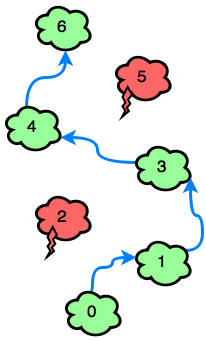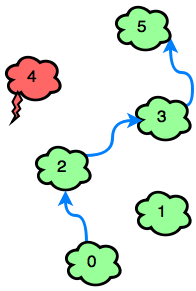Jumping on the Clouds
Emma is playing a new mobile game that starts with consecutively numbered clouds. Some of the clouds are thunderheads and others are cumulus. She can jump on any cumulus cloud having a number that is equal to the number of the current cloud plus or . She must avoid the thunderheads. Determine the minimum number of jumps it will take Emma to jump from her starting postion to the last cloud. It is always possible to win the game.
For each game, Emma will get an array of clouds numbered if they are safe or if they must be avoided. For example, indexed from . The number on each cloud is its index in the list so she must avoid the clouds at indexes and . She could follow the following two paths: or . The first path takes jumps while the second takes .
Function Description
Complete the jumpingOnClouds function in the editor below. It should return the minimum number of jumps required, as an integer.
jumpingOnClouds has the following parameter(s):
- c: an array of binary integers
Input Format
The first line contains an integer , the total number of clouds. The second line contains space-separated binary integers describing clouds where .
Constraints
Output Format
Print the minimum number of jumps needed to win the game.
Sample Input 0
7
0 0 1 0 0 1 0
Sample Output 0
4
Explanation 0:
Emma must avoid and . She can win the game with a minimum of jumps:

Sample Input 1
6
0 0 0 0 1 0
Sample Output 1
3
Explanation 1:
The only thundercloud to avoid is . Emma can win the game in jumps:

This is a simulation problem. Because the problem guarantees that it is
always possible to win, we know that our input will never
contain consecutive thunderclouds. To reach the last cloud in a minimum
number of steps, always try make a jump from to . If that is not possible, jump to .
The Problem Setter's solution below uses this approach. Check out the Problem Tester's solution for a slightly different approach.
Problem Setter's code:
Python 2
n = int(raw_input())
c = map(int, raw_input().split(" "))
ans = 0
i = 0
while i < n - 1:
if i + 2 >= n or c[i + 2] == 1: # Not possible to make a jump of size 2
i = i + 1
ans = ans + 1
else:
i = i + 2
ans = ans + 1
print ans
Ruby
#!/bin/ruby
n = gets.strip.to_i
c = gets.strip
c = c.split(' ').map(&:to_i)
ans = 0
i = 0
while i < n - 1
(i + 2 >= n or c[i + 2] == 1 )? i=i+1: i=i+2
ans = ans + 1
end
print ans
C++
#include <bits/stdc++.h>
using namespace std;
const int inf = 555;
int A[111], dp[111];
int main() {
int n; cin >> n;
for(int i=1; i<=n; i++) {
cin >> A[i];
}
for(int i=2; i<=n; i++) {
if(A[i] == 0) dp[i] = min(dp[i-1], dp[i-2]) + 1;
else dp[i] = inf;
}
cout << dp[n] << "\n";
return 0;
}

Comments
Post a Comment